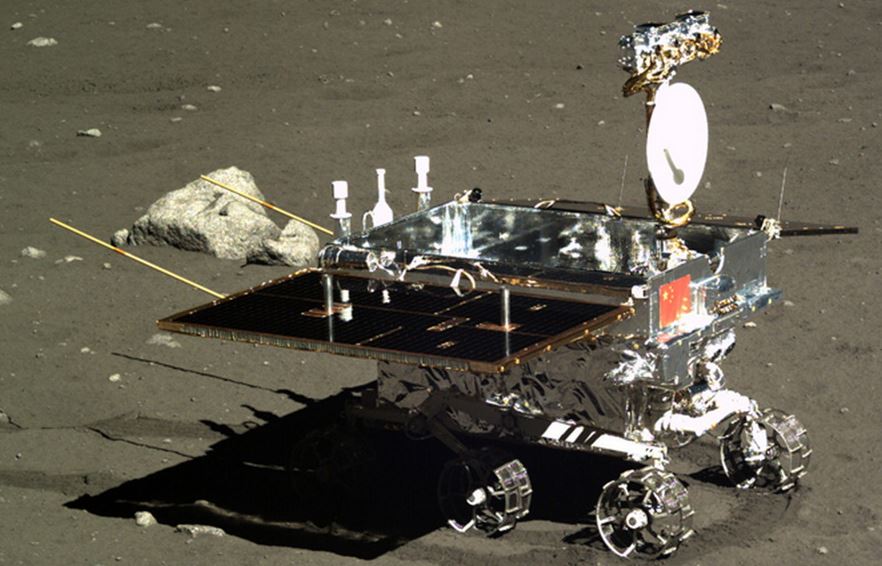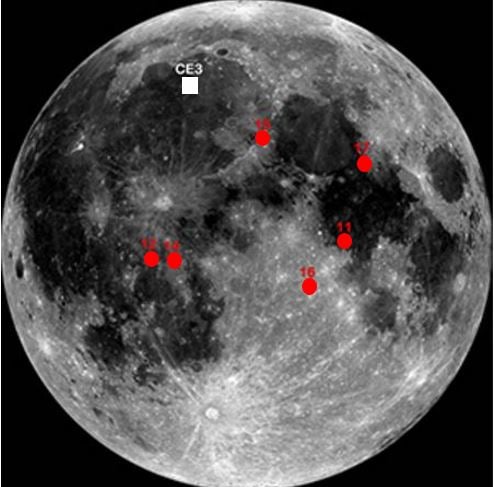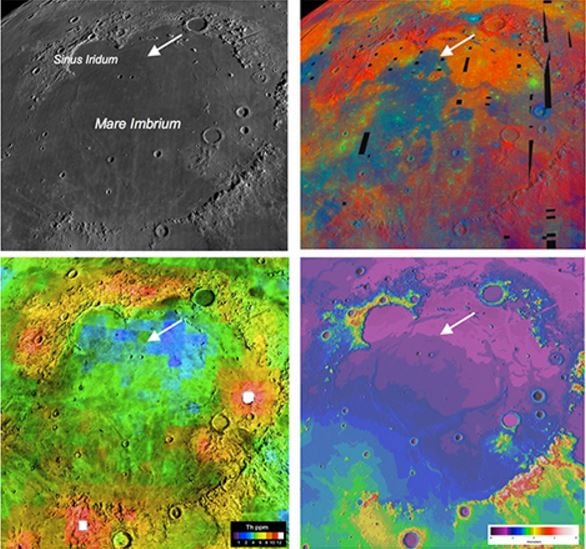The Chinese Moon rover – Yutu – has been analyzing moon rocks unlike anything seen before in previous lunar missions, including those from the American Apollo and Russian Luna sample return missions.
China’s unmanned lunar exploration mission is called Chang’e 3 (嫦娥三号). It is operated by the China National Space Administration (CNSA), incorporating a robotic lander and the first Chinese lunar rover.
The Moon rover got its name – Yutu (玉兔) – after an online poll. Yutu is the mythological rabbit that lives on the Moon and is the pet of the Moon goddess.
 Yutu, the Chinese lunar rover, photographed by its lander Chang’e-3, after the lander touched down in Mare Imbrium. (Image: news.wustl.edu)
Yutu, the Chinese lunar rover, photographed by its lander Chang’e-3, after the lander touched down in Mare Imbrium. (Image: news.wustl.edu)
The Chang’e-3 mission touched down on the Moon in 2013, on the northern part of the Imbrium basin, one of the most prominent lava-filled impact basins that are visible from Earth.
Chang’e-3 mission – A beautiful landing site
According to Bradley L. Jolliff, PhD, the Scott Rudolph Professor of Earth and Planetary Sciences at Washington University in St. Louis, it was a beautiful landing site. Dr. Jolliff forms part of an educational collaboration that helped analyze data from the Chang’e-3 mission.
The lander gently touched down on a smooth flood basalt (dark fine-grained volcanic rock) close to a relatively fresh impact crater – Zi Wei crater – that had conveniently excavated bedrock from below the regolith (the layer of dust, soil, and broken rock of a planet’s surface) for the rover to study.
Since the end of the Apollo program, NASA’s exploration has been conducted primarily from orbit. However, orbital sensors mainly detect the regolith that covers the Moon, which generally consists of a mixture of materials that are difficult to interpret.
Chang’e-3 touched down on a relatively young lava flow, where the regolith layer was thin and not mixed with dust and rock fragments from elsewhere. This meant that it closely resembled the composition of whatever was below ground.
 The white square is Chang’e-3’s landing site in this lunar map. The landing sites of the Apollo missions are in red. (Image: news.wustl.edu)
The white square is Chang’e-3’s landing site in this lunar map. The landing sites of the Apollo missions are in red. (Image: news.wustl.edu)
Comparing in situ findings with orbital sensor data
These characteristics made the landing site the perfect location to compare in situ analysis with compositional data detected by the orbiting sensors.
Dr. Jolliff said:
“We now have ‘ground truth’ for our remote sensing, a well-characterized sample in a key location. We see the same signal from orbit in other places, so we now know that those other places probably have similar basalts.”
The basalts where Chang’e-3 touched down turned out to be completely different from anything brought back to Earth from the Moon.
Dr. Jolliff added:
“The diversity tells us that the Moon’s upper mantle is much less uniform in composition than Earth’s. And correlating chemistry with age, we can see how the Moon’s volcanism changed over time.”
The collection and analysis of this data has been published in the academic journal Nature Communications. Two partnerships were involved in gathering and analyzing data. Researchers from several Chinese institutions involved with the Chang’e-3 mission formed one partnership; and the other was a long-standing educational partnership between Washington University in St. Louis, USA, and Shandong University in Weihai, China.
 These four views of the Mare Imbrium basin and the Chang’e-3 landing site show how different the Moon looks to different types of remote sensing. (Image: news.wustl.edu)
These four views of the Mare Imbrium basin and the Chang’e-3 landing site show how different the Moon looks to different types of remote sensing. (Image: news.wustl.edu)
The Moon – a mineralogical enigma
Scientists believe the moon was created by a collision of a Mars-sized body with the Earth. It started as a molten or partially molten body, which cooled and separated into a crust, mantle and core.
However, when heat built up from the decay of radioactive elements in the interior, parts of the mantle remelted, with molten material erupting onto the surface about 500 million years after the moon was formed, pooling in basins and impact craters to form the maria (a dark region of considerable extent on the Moon’s surface), most of which are on the Earth-facing side of the Moon.
The Apollo (1969-1972) and Luna (1970-1976) missions sampled basalts from the period in the Moon’s history, between three to four billion years ago, when volcanism was at its peak. The Imbrium basin, however, where Chang’e-3 landed, contains some of the younger flows – about 3 billion years old, or marginally less.
 Panoramic view of the ‘Zi Wei’ crater. This photo was taken by the Panoramic Camera on the Yutu rover at the CE3-0008 site. (Image: www.nature.com)
Panoramic view of the ‘Zi Wei’ crater. This photo was taken by the Panoramic Camera on the Yutu rover at the CE3-0008 site. (Image: www.nature.com)
No intermediate titanium content levels in previous mission samples
The basalts brought back to Earth from the American and Russian missions had either very high or low titanium content – there were no intermediate values. Measurements by a near-infrared hyperspectral imager and an alpha-particle X-ray spectrometer aboard the Yutu showed that the basalts at the Chinese mission’s landing site are intermediate in titanium, and rich in iron, said first author, Dr. Zongcheng Ling, associate professor in the School of Space Science and Physics at Shandong University in Weihai.
Titanium is extremely useful in mapping and understanding volcanism on the Moon, because its concentration varies considerably – from less than 1 weight percent TiO2 to more than 15%. This variation reflects considerable differences in the mantle source regions that derive from the time when the early magma ocean initially solidified.
Minerals crystallize in specific order
Dr. Alian Wang, research professor in earth and planetary sciences in Arts & Sciences at Washington University, explained that minerals crystallize from basaltic magma in certain order. Usually, the first to crystallize are olivine and pyroxene, two minerals rich in magnesium and iron that are slightly denser than the magma, and sink down through it. Then the less dense mineral plagioclase feldspar, which floats to the surface.
This process of separation through crystallization led to the formation of the mantle and crust of the moon as the magma ocean cooled.
The titanium ended up in ilmenite (FeTiO3), a mineral that typically does not crystallize until a very late stage, when just 5% of the original melt remains. When it finally crystallized, the dense, ilmenite-rich material sank into the mantle, forming areas of Ti enrichment.
Dr. Jolliff said:
“The variable titanium distribution on the lunar surface suggests that the Moon’s interior was not homogenized. We’re still trying to figure out exactly how this happened. Possibly there were big impacts during the magma ocean stage that disrupted the mantle’s formation.”
Chang’e-3’s landing site rich in olivine and titanium
There is another twist in the story that underscores the importance of checking data obtained from orbital sensors against ground truth. The remote sensing data showed that Chang’e-3’s landing site was rich in olivine and titanium.
Dr. Wang said that does not make sense, given that olivine generally crystallizes early on and the titanium-rich ilmenite crystallizes much later. Finding a rock that has high levels of both is a bit weird.
However, Yutu solved this mystery too. In olivine, silicon is paired with either iron or magnesium, but the ratio of these two elements varies depending on the forms of the mineral. The early-forming olivine is magnesium rich, while the olivine that Yutu detected has a composition ranging from intermediate in iron to iron-rich.
Dr. Jolliff said:
“That makes more sense, because iron-enriched olivine and ilmenite are more likely to occur together. You still have to explain how you get to an olivine-rich and ilmenite-rich rock. One way to do that would be to mix, or hybridize, two different sources.”
The researchers infer that in the late stage of magma-ocean crystallization, iron-rich ilmenite and pyroxene, which formed late and at the mantle-crust boundary, might have started to sink, and early-formed magnesium-rich olivine could have started to rise. The two minerals may have mixed and hybridized as this occurred.
Dr. Jolliff said “Given these data, that is our interpretation.”
Anyway, it is evident that these newly characterized basalts show that the Moon is much more diverse than had previously been thought from the analyses of samples brought back during the Apollo and Luna missions.
Dr. Jolliff said:
“Remote sensing suggests that there are even younger and even more diverse basalts on the Moon, waiting for future robotic or human explorers to investigate.”
Citation: “Correlated compositional and mineralogical investigations at the Chang′e-3 landing site,” Zongcheng Ling, Bradley L. Jolliff, Alian Wang, Chunlai Li, Jianzhong Liu, Jiang Zhang, Bo Li, Lingzhi Sun, Jian Chen, Long Xiao, Jianjun Liu, Xin Ren, Wenxi Peng, Huanyu Wang, Xingzhu Cui, Zhiping He & Jianyu Wang. Nature Communications. 22 December 2015. DOI: 10.1038/ncomms9880.
Video – Chinese rover discovers new moon rock

